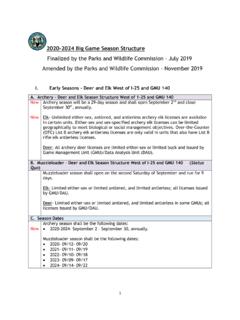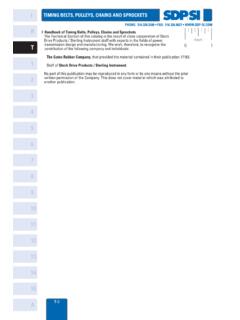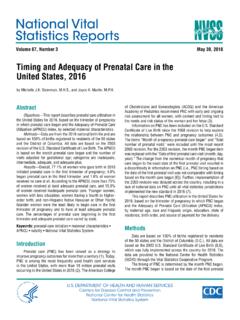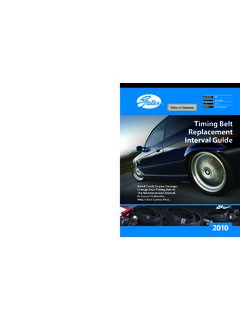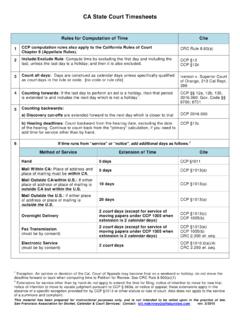Transcription of Top 5 Timing Closure Techniques - Xilinx
1 Top 5 Timing Closure Techniques Greg Daughtry Correct Timing Constraints Analyze Before Doing Implementation Strategies and Directives Congestion and Complexity Advanced Physical Optimization Create Good Timing Constraints Create constraints: Four key steps 1. Create clocks 2. Define clocks interactions Baseline Constraints 3. Set input and output delays 4. Set Timing exceptions Use Timing Constraint Wizard Powerful Constraint Creation Tool Validate constraints at each step report_timing_summary Monitor unconstrained objects check_timing Validate Timing report_clocks (Note: Tcl only). Debug constraint issue post-synthesis report_clock_networks Analysis will be faster report_clock_interaction XDC and Timing DRCs Report CDC.
2 Establish a Good Starting Point Baseline with Timing Constraint Wizard Disable user XDC file(s). Leave IP XDC files as is Create baseline XDC file, set as target Run Timing Constraints Wizard Constrain all clocks and clock interactions Flag CDC issues by running Report CDC. Skip IO constraints in first pass Iterate through P&R stages, validate Timing at every stage Add exception constraints where necessary Core Flop-to-Flop Timing can be met Add IO & other exception constraints in subsequent passes Iterate through P&R stages, validate Timing at every stage of flow Correct Timing Constraints Analyze Before Doing Implementation Strategies and Directives Congestion and Complexity Advanced Physical Optimization World Class Analysis Make Sense of Your Design Data 45 Reports Give Critical Design Info Clocks and clock interaction Placer/Router/Optimization Status Timing Analysis and Constraints DRC.
3 Design Complexity Control Sets Utilization IP Upgrade Status Power Vivado% help report_*. Log files have Context-sensitive Information Every action in order of execution Severity levels: Info, Warning, Critical Warning, and Errors Progressive Estimation Accuracy As stages progress from pre-synth to final route signoff . Report Design Analysis Report Types Timing Key netlist, Timing and physical critical path characteristics Combination of characteristics that lead to Timing violations Logic levels distribution per destination clock Complexity Logical netlist complexity Metrics and problematic cell distribution Complexity may lead to Congestion Congestion Congestion seen by placer, router Top contributors to SLR crossings Extended Timing Report Setup analysis: show the paths before and after the critical path report_design_analysis -extend -setup See how much slack is available from surrounding paths.
4 Logic Level Distribution report_design_analysis Number of logic levels in top 5000 critical paths Default number of paths cannot be changed ( will fix this). Table can be generated for specific paths using -of_timing_paths Identify longest paths (outliers) and modify the RTL. Reduces placer focus on few difficult paths only Expands placer solutions and optimization range Clock Domain Crossing Report report_cdc Identifies CDC topologies Reports unsafe crossings and constraint issues Structural issues reported even if exception constraints exist Excellent cross-probing support View schematics and exact line number in RTL. Correct Timing Constraints Analyze Before Doing Implementation Strategies and Directives Congestion and Complexity Advanced Physical Optimization Try All The Tool Options SmartXplorer Style Launch a run for every strategy Easy To Try Pick the best one from design runs table Runs Infrastructure Supports Grid Computing Built-in parallel runs on different hosts (Linux).
5 LSF and Sun Grid Engine Don't Expect This Will Solve All Your Problems Vivado Implementation Strategies and Directives Directive: directs command behavior to try alternative algorithms Enables wider exploration of design solutions Applies to opt_design, place_design, phys_opt_design, route_design Strategy: combination of implementation commands with directives Performance-centric: all commands use directives for higher performance Congestion-centric: all commands use directives that reduce congestion Flow-centric: modifies the implementation flow to add steps to Defaults power_opt_design post-route phys_opt_design Faster Higher Compile Performance Quick Runtime Default Explore Optimized Implementation Strategies Strategy Name Objectives Defaults Balance between Timing Closure effort and compile time Performance_Explore Multiple passes of opt_design and phys_opt_design, advanced Performance_ExplorePostRoutePhysOpt placement and routing algorithms, and post-route placement optimization.
6 Optionally add post-route phys_opt_design. Performance_NetDelay_* Makes delays more pessimistic for long distance and higher fanout nets with the intent to shorten their overall wirelength. Low, medium, and high settings (high = high pessimism). Performance_WLBlockPlacement Prioritize wirelength minimization for BRAM/DSPs Congestion_SpreadLogic_* Spread logic to aggressively avoid congested regions (low, medium, and high settings control degree of spreading). Performance_ExploreSLLs Timing -driven optimization of SLR partitioning Congestion_BalanceSLLs Algorithms for alleviating congestion in SSI designs: Balance SLLs Congestion_BalanceSLRs between SLRs, balance utilization in each SLR, spread logic (SSI- Congestion_SpreadLogicSLLs tailored algorithms), compress logic in SLRs to reduce SLLs Congestion_CompressSLR.
7 Correct Timing Constraints Analyze Before Doing Implementation Strategies and Directives Congestion and Complexity Advanced Physical Optimization Congestion Physical regions with High pin density High utilization of routing resources Placer congestion Congestion-aware: balances congestion vs. wirelength vs. Timing slack Smear Maps Cannot always eliminate congestion Cannot anticipate potential congestion introduced by hold fixing Timing estimation does not reflect detours due to congestion Reports congested areas seen by placer algorithms Router congestion Routing detours are used to handle congestion at the expense of Timing Reports largest square areas with routing utilization close to 100%.
8 Placer congestion tends to be more conservative than router Complexity Report Complex modules in lower hierarchy Rent's Rule: report_design_analysis -complexity [-hierarhcial_depth N] = . High Rent ( ), Avg fanout on larger instances High LUT6%, MUXF* utilization Congestion Report Example report_design_analysis -congestion Placer congestion section Window defined in CLB tiles Top contributors to the region find cells using: Largest congested region get_cells -hier <Name>. Note: In -congestion must be run in same session as place_design and route_design Placer Congestion Report Example Placed tile-based section (smear metrics tables). Top contributors to the region find using: get_cells -hier <Name>.
9 Routing Congestion report_design_analysis -congestion Graphical View Text Report Actual routing resource utilization Window dimensions Size of region Potential Solutions for Congestion Reduce Logic or Pick a Bigger Device Look for wide bus and mux structures Optimize modules in congested regions Disable LUT combining design-wide or in congested instances Globally with synth_design -no_lc set_property SOFT_HLUTNM [get_cells -hier -filter {name =~ instance/*}]. Consider OOC synthesis with different options, strategies Turn off cross-boundary optimizations in synthesis Globally with synth_design -flatten_hierarchy none On specific modules with KEEP_HIERARCHY in RTL.
10 Try several implementation strategies or placer directives Try congestion-oriented placer strategies and directives first Try other strategies and placer directives => Re-use some or all RAMB and DSP placement from good runs Try floorplanning the congested logic Prevent complex modules from overlapping Consider dataflow through device Correct Timing Constraints Analyze Before Doing Implementation Strategies and Directives Congestion and Complexity Advanced Physical Optimization Post-Place Physical Optimization Can Make a Big Difference Many useful Tricks are implemented Replication (based on fanout, Timing or specified nets). BRAM/DSP/SRL register optimization Retiming Moving cells to better location after each optimization Not part of the default strategies You need to choose the tradeoff in extra runtime Designed to be Re-entrant.










